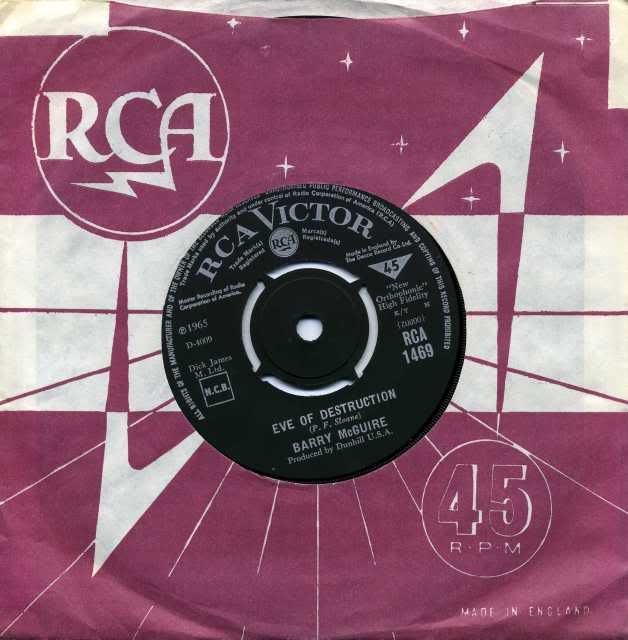
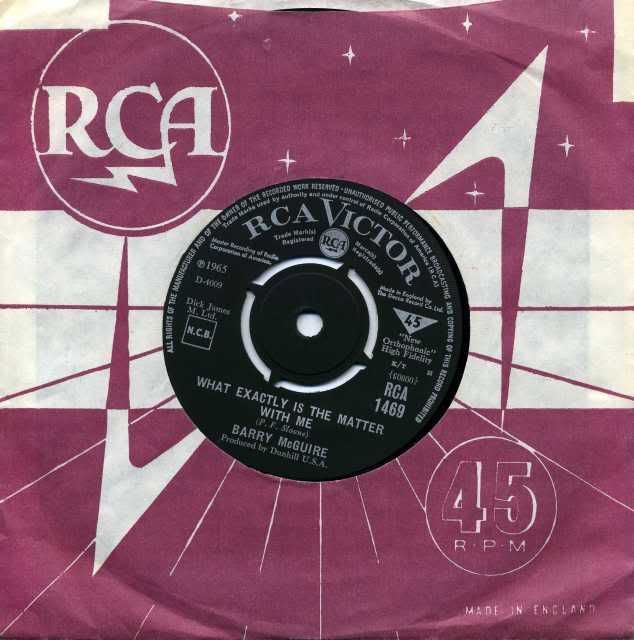
What Exactly Is The Matter With Me
Thanks to Chris Low for the photographs of the G20 protests which occurred in the City of London yesterday, and to those folk that participated throughout that day in the largely peaceful protest for a safer, cleaner and fairer global society. Reports below lifted from various media.
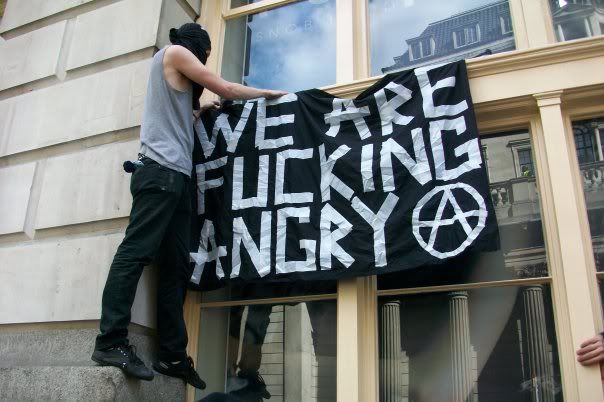
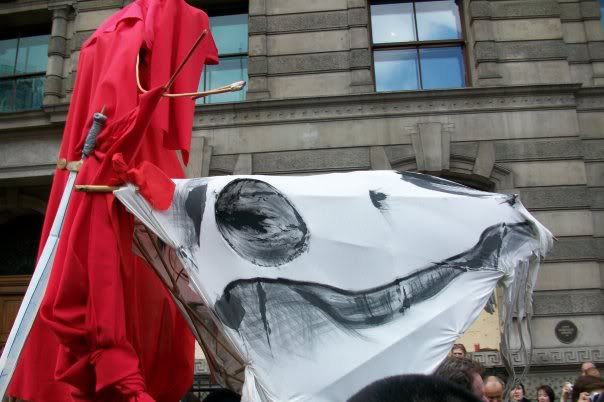
Protesters have stormed the Royal Bank of Scotland in London as thousands of people descended on the City ahead of the G20 summit of world leaders.
Demonstrators launched missiles and forced their way into the bank after clashes with police in the capital.
Nineteen people were arrested on Wednesday, while some police and protesters were injured in scuffles.
Climate change activists have pitched tents in the street, while anti-war campaigners are holding a rally.
The protests came as US President Barack Obama spoke of the “sense of urgency” needed to confront the financial crisis after he met Prime Minister Gordon Brown at Downing Street.
By Wednesday afternoon the prime minister’s spokesman said they were hoping to reach a successful conclusion to the summit.
At the height of the demonstrations, the police estimated there were up to 4,000 demonstrators in the City and officers cordoned off a number of streets.
The BBC’s Ben Brown said there had been an “increasingly ugly mood” in Threadneedle Street after protesters smashed RBS windows with missiles, including coins and computer keyboards, and entered the building. The branch had been closed already as a precautionary measure.
Mounted police and riot officers used shields to push demonstrators back and officers said they entered the RBS building just after 1400 BST “in support of building security”.
The £703,000 pension arrangement of RBS former chief executive, Sir Fred Goodwin, has sparked public anger.
An RBS spokesman said: “The safety of our employees and our customers is of paramount importance to us.”
However, by mid afternoon the BBC’s Danny Shaw said police sources believed the mood had changed, with the atmosphere becoming less tense.
Officers were on the look out for people who were “of interest”.
Earlier, officers were pelted with empty beer cans, fruit and flour outside the Bank of England as the crowd of demonstrators had attempted to reach a peaceful climate change protest in nearby Bishopsgate.
Hundreds of Climate Camp demonstrators – behind direct action protests at Heathrow Airport and power stations in North Yorkshire and Kent – pitched tents in protest against carbon markets.
The BBC’s Mark Georgiou said there was an “almost Glastonbury atmosphere” at the demonstration outside the European Climate Exchange, which featured “music and meditation”.
Several hundred anti-war demonstrators have also marched to a rally in Trafalgar Square from the US Embassy in central London.
The BBC’s Dominic Casciani said it had a “completely different mood” to the protests in the City, and demonstrators were in peaceful mood.
Earlier, protest groups under the G20 Meltdown banner had marched to the Bank of England in the City urging those who had lost their homes, jobs, savings or pensions to join them in following four “horsemen of the apocalypse” to “lay siege” to financial institutions.
Many City workers have dressed in casual clothes after banks and other institutions were warned they may be targeted.
Protester Daniel Blinkhorn, from Brighton, was among those marching from London Bridge station to the Bank. He said the G20 leaders had a “real opportunity to green the global economy”.
Housing association worker Tony Streeter told the BBC: “I’m here because I think people are angry about what’s going on in the world there’s too much greed.”
Scotland Yard said a total of 23 people had been arrested in connection with the protests, including four on Tuesday.
The four people were charged after officers were alerted to a group trying to break into a building in the Holborn area of central London, police said.
On Wednesday, police questioned demonstrators travelling in an armoured vehicle dressed in helmets and overalls.
Police say 11 people have been arrested on suspicion of possessing police uniforms and for road traffic offences.
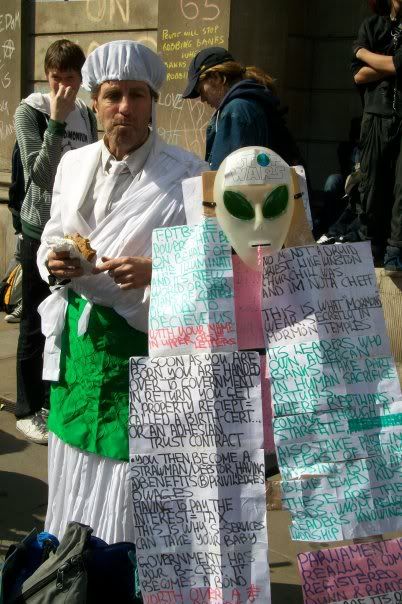
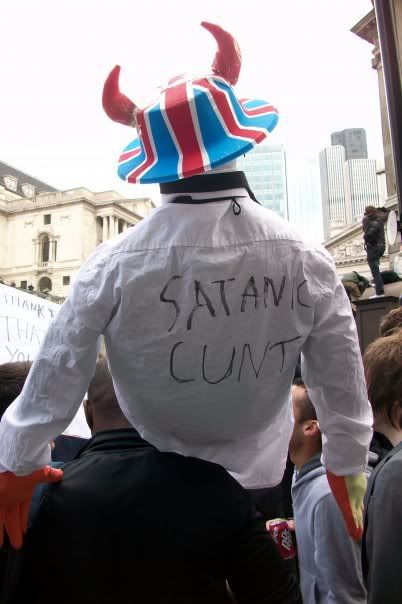
A man died last night during the G20 protests in central London as a day that began peacefully ended with police saying bottles were thrown at police medics trying to help him.
The man had collapsed within a police cordon set up to contain the crowds who had assembled in central London and the City to protest over the G20 summit. There were 63 arrests on the day.
The Independent Police Complaints Commission was being notified last night. Scotland Yard said the alarm had been raised by a member of the public who spoke to a police officer on a cordon at the junction of Birchin Lane and Cornhill in the City.
He sent two medics through the cordon line and into nearby St Michael’s Alley where they found a man who had stopped breathing. They called for ambulance support at about 7.30pm and moved him back behind the cordon where they gave him cardio-pulmonary resuscitation.
“The officers took the decision to move him as during this time a number of missiles – believed to be bottles – were being thrown at them”, said a police statement. The ambulance service took the man to hospital where he died.
A London ambulance spokesman said: “Our staff immediately took over the treatment of the patient and made extensive efforts to resuscitate him both at the scene and on the way to hospital.”
The directorate of public standards at both the Metropolitan and City of London police had been informed, the statement said. One protester at the scene said the man was in his 30s and died of natural causes, the Press Association news agency reported.
The man’s death ended a day in which the contrasting faces of British policing were on display in London.
The Met called in support from 30 forces across the country to create a 5,000-strong team of officers for at least six diverse demonstrations in the City of London and Trafalgar Square. Outside the Bank of England police horses and riot officers were pushed back by the sheer force of demonstrators – helmets were torn from officers’ heads and cans, fruit and flour rained down. In retaliation the police surged forward, cracking heads with batons, using pepper spray and CS gas, and sirens wailed all around.
Three minutes’ walk away, in Bishopsgate, smiling officers shared a joke with men and women pitching tents along the road, a family offered them chocolate brownies from an organic food stall and a few lads politely queued up outside the compost toilet tent.
But late last night there was a stand-off as officers moved to start to break up the climate camp that had been set up.
Violence spread as far as London Bridge, with riot police chasing groups of demonstrators, who responded with bottles and other missiles.
Commanders at the Met, who are said to be among the best public order officers in the world, insisted they would not let the city be brought to a standstill.
They used familiar tactics to trap 4,000 people into streets outside the Bank of England in a practice known as “kettling”, tightening the cordon when violence flared in one part of Threadneedle Street and a group of protesters, whose faces were covered, broke into the Royal Bank of Scotland.
Commander Bob Broadhurst, in charge of the operation, said his aim was to facilitate peaceful protest. But those peaceful demonstrators caught inside the cordon with no toilet facilities, and little water, questioned the idea that they were being allowed to exercise their right to march.
“The police should let us dribble out when we need to,” said June Rogers, a gardener from south London. “We’ve just come on a peaceful protest. We’ve got fire in our belly and we want to say something and be heard, we are just ordinary people but they made the situation worse.”
Jeannie Mackie, a barrister who had attended the climate camp as an observer, was penned in for two hours after police cordoned off both ends of Bishopsgate.
“I thought it was completely unnecessary,” she said.
“I was kept for two hours. Lines of police lined up with their batons and they were completely pumped up and looking to have a go. My feeling was everyone in there was peaceful but they wanted to clear them out.” Responding to the police use of the kettling technique she said that although the courts had ruled that it was legal, there had to be a good reason. “I asked one officer could I go and he said no – I might to and cause trouble. I giggled and said that wasn’t very likely and he said, ‘you can never tell with these people’.”
Scotland Yard said a cordon was used because missiles were being thrown at officers. It also said that portaloos and water had been moved in.
Earlier in the day demonstrations had started close to the Bank of England, storming a Royal Bank of Scotland branch, and baton-wielding police charging a sit-down protest by students.
Much of the protesting was peaceful, but some bloody skirmishes broke out as police tried to keep thousands of people in containment pens surrounding the Bank of England on Threadneedle Street.
Some buildings in the City had been boarded up in anticipation of trouble, with staff warned to work from home or dress down.
As protesters began to gather, after 11am, some City workers were seen waving £10 notes at them from office windows.
After the charge against the sit-down protest at students, there were complaints that officers had been heavy handed.
“When people surrounded RBS, I could understand police tactics,” said Jack Bright, 19. “We were sat down, trying to have a peaceful protest, but they started whacking us.”
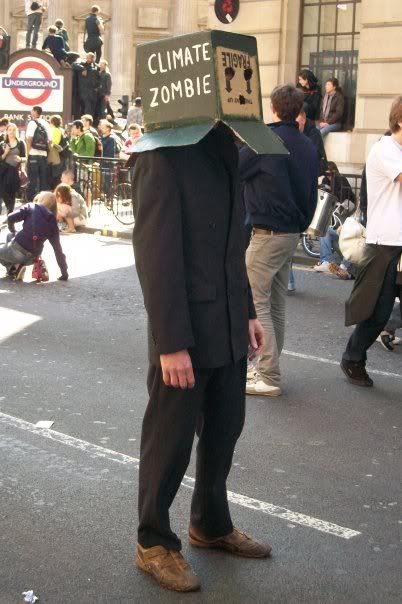
Riot police broke down the doors of two squats in East London yesterday as they hunted for those involved in the violence outside the Bank of England during Wednesday’s protests.
Police said that they had made 111 arrests so far in connection with the march and were happy with the way that Operation Glencoe had gone.
It emerged that the man who collapsed and died during the protest on Wednesday evening had been returning from work. Ian Tomlinson, 47, was not involved in the march.
When the protesters met in the City of London at the Bank of England and pushed towards the Royal Bank of Scotland police were initially overrun but quickly regained control.
Officers have been accused of heavy-handedness after hitting protesters with their truncheons and penning in demonstrators outside the Bank of England.
Commander Simon O’Brien, of the Metropolitan Police, said of the decision to pen in the crowds: “If there had been no disorder we would have allowed people to move more freely. But peaceful protests were hijacked by a small number of people. We were pragmatic, we took a lot and I don’t accept that officers have to stand there being punched without any response.”
Climate Camp activists said that the police over-reacted as they evicted them from a protest in Bishopsgate. A spokeswoman said: “We said we would stay peacefully overnight but by 1.30am hundreds of riot cops forced their way through while protesters sat with their hands in the air saying, ‘This is not a riot’. We were forced out and the police used dogs. It was scary.”
More than 20 people were arrested during the raids on the two squats yesterday. Police used battering rams to break down the doors of a squat on Earl Street, near Liverpool Street station, which had been barricaded for several days, and led 70 people out of the building in handcuffs. The second address was in nearby Whitechapel.
Three teenagers and a man were charged last night in connection with the storming of RBS. Mindaugas Lenartavicius, 21, will appear at Westminster Magistrates’ Court today.
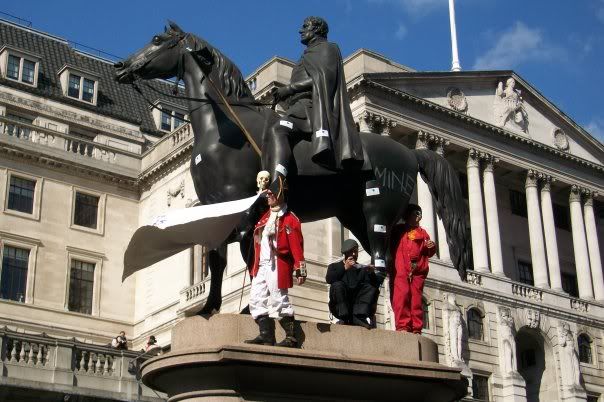
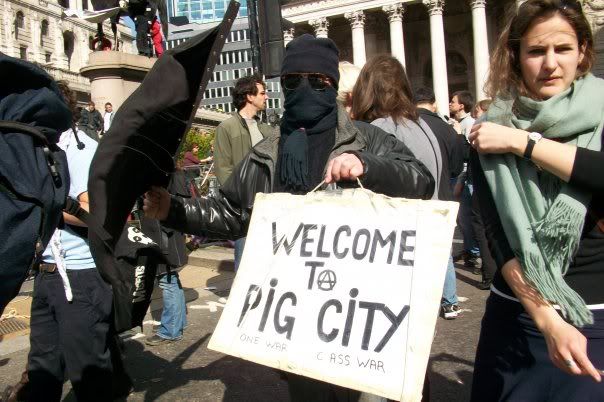

Andus
May 15, 2009 at 9:54 pmLearn from the experience with Police provocateurs disguised themselves as demonstrators during the protest at the North American leaders summit in Montebello in Canada.
http://www.youtube.com/watch?v=BWbgnyUCC7M
they even admitted it
http://www.youtube.com/watch?v=gAfzUOx53Rg
Chris
May 16, 2009 at 1:16 amThanks for posting that. Quite clearly an instance of covert police tactics and something i hope all folk who go on demos don’t doubt goes on here too. Though I DO still have doubts regarding the veracity of claims that these cops were ‘agent provocateurs’ rather than, as one would expect, masking up to blend in with the immediate crowd and acting in a manner that would enhance their potential for intelligence gathering/identifying suspects/making arrests for the simple reason it just doesn’t make sense. If no one is attacking (in particular chucking rocks at the police) why on earth would they initiate this? And if folk WERE, why would they join in? I really cannot see a logical connection.
However having re-read your original post above (and having personally BEEN there on the day and being coralled in) i can say that with regard to the statement:
“There is a logic having plain-clothes officers in the crowd, but no logic if the officers are actively encouraging violence, which would be a source of great concern,” [Brake said]
Some of the cops there on the day were so clearly out of control and intent on violence, for all i know some MAY WELL have gone a bit ‘Rambo’. Though as everyone in London knew it was inevitable there would be some sort of trouble on the day I still have reservations about why they even thought it was neccesary. Did some chief commissionar in Scotland Yard really think he needed to deploy two plod in civvies to gee up the crowd as there was a chance nothing would happen otherwise and everyone would just hold hands and try to make the BOE levitate?
And , with respect to Brake’s other claim:
“The MP said that given only a few people were allowed out of the corralled crowd for the five hours he was held inside it, there should be no problem in investigating the allegation by examining video footage.”
This is simply untrue. Whether he was unaware that hundreds of people were let out or not, i do not know.
But generally i tend not to believe what politicians say 😉
Chris
May 16, 2009 at 10:07 pmThere is also the elementary fact that a demo without ANY incident of violence or trouble is a victory for the police. Anything else incurs public enquiries and questions to parliament, something I very much doubt any police force would wish to initiate.
Andus
May 17, 2009 at 12:03 pmThe behaviour of the police at most demo’s would contradict the above assertion.
Chris
May 17, 2009 at 8:52 pmSorry, I’m a bit confused. You cannot seriously be suggesting that the old bill WANT trouble and folk lobbing rocks at them on demos? Really think you’d better check this link out mate: http://www.stlyrics.com/songs/c/chazndave5797/snookerloopy231992.html
Andus
May 17, 2009 at 11:58 pmVery funny. I didn’t mean that at all, you did text, Quote, ‘without ANY incident of violence or trouble is a victory for the police’; ANY being the operative word. I wasn’t suggesting they enjoyed having rocks (so its rocks now, what happened to the bottles, run out?) thrown at them.
Chris
May 18, 2009 at 1:27 amSorry mate, and excuse me, but I really don’t get your point….
I wrote –
“a demo without ANY incident of violence or trouble is a victory for the police”
– a statement I stand by as i believe it to be irrefutably correct.
Likewise, I cannot see why police would ever deploy ‘agent provocateurs’ to incite and provoke an otherwise peaceful demo into violence. There is no logic to it. And the plod will get their overtime anyway; it’s not like they get a bonus for every ‘direct hit’ they receive, like that end-of-pier amusement where the chipmunks come out of the holes and you have to bop them over the head with a big plastic mallet to win a prize.
Andus
May 18, 2009 at 9:39 amYou also wrote, ‘Some of the cops there on the day were so clearly out of control and intent on violence, for all i know some MAY WELL have gone a bit ‘Rambo,’. so you’ve gone from that to this.,, ‘“a demo without ANY incident of violence or trouble is a victory for the police”.
slyme68
May 18, 2009 at 2:19 pmThe principles of provocation are quite simple. On their side, they will attempt to create a pretext for an assault on the demo/thing they don’t like so that they can break heads, nick people, get dna/photos/names/charges. On our side, a legitimate act which contains a taunt provokes an over reaction prompting outrage and exposing the brutality of the system. On balance, i’d say that the provocation was won by our side this time.
Chris
May 18, 2009 at 3:18 pmOh dear. A familiar sense of deja vu descends…
No. There is no contradiction whatsoever in those statements. The old bill’s role at most demos is ‘crowd control’ thus – ‘“a demo without ANY incident of violence or trouble is a victory for the police” as they have ‘lost control’ when a demo turms violent and (tokenist though it may be) they will – ostensibly, as we all know this is never the case- be held ‘accountable’ through public enquiry/questions asked in the commons and the usual impotent, innefectual channels.
Also please bear in mind I am talking about DEMOs which are generally public events. Obviously is this different from Stonehange 85, Orgreave, the Dublin 2002 ‘reclaim The Streets’ (which I witnessed) or other mass events at which the police HAVE taken an offensive aproach – initiating (invariably unprovoked) violent attacks on citizens.
Andus
May 18, 2009 at 5:10 pmThe point I was trying to make on the 1203pm post, is this. Your assertion that the police never want violence would appear to be contradicted by the amount of times the police have gone over the top on demo’s, attacking innocent people for instance. As appears to have been the case at this G20 thingy. If they don’t want violence, why incite it? I’m not talking about ‘agent provocateurs’ here either.
Chris
May 18, 2009 at 6:03 pmOk, I see what you mean. I think it is more a case of the directive they are given. In the instance of G20 they were clearly instructed to act in a very heavy handed manner (“extreme prejudice” I believe being the euphemism) to the slightest potential incident. G20 was a possibly unprecedented success in terms of police tactics. There was no riot (apart from the sacrificial lamb of the RBS building having its windows penned in, which was all fixed for business as usual the next day), hardly any injuries to police, clearly a vast amount of intelligence gathering and i’d imagine from the majority of law-abiding protestors who were coralled in and peacefully dispersed after release a hell of a lot of people who will never consider going on a demo again. G20 in my view represented more than anything a very tangible line being drawn in terms of police tactics and how protests will be policed in the future.
My original assertion was simply that I do not believe the police would employ ‘agent provocateurs’ to INCITE attacks on themelves when this: a) isn’t going to happen [or] b) is going to happen anyway; in response to your assertion of Brake’s claim that:
“There is a logic having plain-clothes officers in the crowd, but no logic if the officers are actively encouraging violence, which would be a source of great concern”
John Serpico
May 20, 2009 at 8:02 amJust as its standard procedure for the police to film and photograph every demo they attend so it is to place plain-clothed officers in amongst the demonstrators. The operational reason for doing this, I presume, is to spot ‘troublemakers’ and point them out to be arrested later. This is standard practise for football crowds too, of course. Without question there were plain-clothed police at the G20 protest but whether they were agent provocateurs is another question entirely.
Personally, I dont believe the plain-clothed police on that day had been given orders to incite protesters at all. Why would they when quite openly the uniformed police were willing and capable of doing it themselves? A lot of the police on that day, however, seemed to be out of control, acting as gangs or individuals way beyond any commands they might have initially been given. The uniformed police were acting on their own violation so why not the plain-clothed police too? It was a police free-for-all. Viewed like this it ends up as a question of semantics as to whether the plain-clothed police were agent provocateurs or just mere ‘spotters’ going way beyond their remit?
Having said that, none of us actually know what direct or indirect commands any of the police were actually given – by whom and from how far up the command chain. Its pretty obvious though that the police on that day were ‘up for it’, which suggests that they had been primed and prepared beforehand to be like this.
And regarding the clip of film from The Guardian showing baton-weilding, plain-clothed police striding forward with their uniformed mates, surely I cant be the only one who finds this image uniquely disturbing?
chris
May 20, 2009 at 3:04 pmVery good comment mate. I agree entirely.